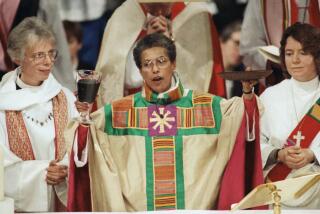Lack of Dialogue Fosters Church Dissent
- Share via
Within the next few weeks Sisters Patricia Hussey and Barbara Ferraro, who in 1984 signed a statement calling for dialogue about abortion in the Roman Catholic Church, may be dismissed from their order, the Sisters of Notre Dame de Namur. Their “offense” is refusing to keep their pro-choice views silent until a policy of dissent is developed within their order.
This may read as another incident of the Vatican’s great bureaucratic arm reaching across the ocean and cracking down on two dissident nuns. However, the issues are more complex. What makes this case noteworthy is that it reveals the tension between the nuns’ independent moral agency and the religious order, the inadequacy of the church’s teaching on sexual matters and the deficiency of the church bureaucracy in handling faithful dissent. None of these involve core infallible teachings of the church.
Sister Patricia and Sister Barbara, who work with poor and homeless women in Charleston, W.Va., view the church as male-dominated, with regulations that, under the banner of moral leadership, threaten and diminish the lives of millions of women. In particular, they hold that church teaching on sexual matters is grounded in institutionalized sexism. Further, they hold that it is both their right and responsibility to be witnesses to their moral conviction of a pro-choice stance.
The Notre Dame general council wants the two sisters to develop the public statement of their moral opinions in discussion with the broader religious order. The council is concerned that their pro-choice statements give grave scandal in suggesting that theirs is a church-sanctioned view. The superiors state they are not acting under pressure from anyone and are open to an alternative solution. Much is at stake here for the Sisters of Notre Dame and all religious orders of women--and all Catholics, for that matter.
The church possesses a rich history of social teaching. Over time this body of teaching shifted from a classicist approach to a historical consciousness approach to deal with social and ethical questions.
Classicism emphasizes the eternal, the immutable and the universal. The social ethic developed from this approach is absolute law and applies to all persons everywhere and at all times.
The historical consciousness approach,which evolved during this century, emphasizes inductive reasoning and the responsible individual, and takes into consideration the “signs of the times”.
Catholics in the United States experienced the latter approach in the recent pastoral letters of their bishops on peace and the economy. Both are examples of the church developing a social ethic to apply to new crises facing humankind.
The church has not adopted this approach in its sexual teaching, as is evident from recent church documents. Members of the church who, like Sister Patricia and Sister Barbara, understand the shift from an ethic of law to an ethic of responsibility are caught in the middle.
What do these caught-in-the-middle Catholics do? Statistics indicate that a large percentage of them ignore the hierarchical church’s teaching on sexual matters. However, when issues of human sexuality arise in individual Catholics’ lives, many seek moral guidance from their local priests or nuns. Here, in the working ranks of the church, absolute theological principles clash with pastoral guidance appropriate for the diversity of today. Parish ministers--priests and nuns like Sister Patricia and Sister Barbara--live the tension rooted in the conflict of these ethical perspectives.
The church’s bureaucratic structure is a large part of the problem. With no representative forum for moral dialogue, Catholics are at times forced to conduct the church’s moral discourse in the public arena. Some church officials interpret public questioning and dissent as disloyal.
The Vatican’s understanding of authority hinders a vibrant and healthy exchange of opinion among church members; in the process, it can become a denial of diversity. This was the effect of the case involving Sister Patricia and Sister Barbara. The church’s prompt move against those who signed the statement, which appeared as a paid advertisement in the New York Times, led to an erroneous assessment that all those who called for dialogue on abortion were pro-choice. My research and interviews with signers of the statement indicate that this is not true.
Church history offers a possible solution to this ethical and bureaucratic dilemma. If teaching authority resides with the entire church, as John Cardinal Newman argued a century ago, then the laity need to reclaim their rightful function as significant partners in dialogue with the hierarchy. The collegial form for dialogue that Newman suggested does not mean a diminished role for the hierarchy but rather an enhancement of the role of the laity.
This is precisely what the signers of the 1984 statement sought. Unfortunately, the selection of a national newspaper as a forum in which to discuss internal church matters, and the Vatican’s swift, punitive reaction against the priests and nuns who signed, buried the real issue of shared ethical decision-making.
If the Notre Dame general council does move for the sisters’ dismissal, it will establish that its members’ moral witness is circumscribed to the extent by which the order has to give public adherence to official church doctrine. If the general council chooses not to act, it leaves in doubt whether individual members are accountable for their own moral stances to the religious order’s as yet unclarified position.
The question, for Sister Patricia and Sister Barbara, is stark: Should women bound in vowed relationship with a religious order (for 25 and 20 years, respectively) be dismissed because of an undeveloped internal policy of dissent that mirrors the undeveloped sexual ethical teaching of the larger church?
Whatever the outcome, the challenge remains for all women in religious orders: to become morally mature and forge their autonomous agency with their communal life, demonstrating that they see the real issues behind the case of Sister Patricia Hussey and Sister Barbara Ferraro. What is needed is a creative alternative to dismissal, one that will allow dissenting sisters and the religious order to maintain their integrity. One such solution might be a category in which the sisters could live within their profession of vows but outside the jurisdiction of canon law. This, rather than the extremity of what amounts to divorce, would buy time for the sisters, the order and the church to reflect and achieve an understanding. It would respect the individual consciences of the sisters and distance the Notre Dame order from their publicly stated moral positions. And this solution holds the possibility that religious orders of women may develop a model forum for moral dialogue that the church so desperately needs.
More to Read
Sign up for Essential California
The most important California stories and recommendations in your inbox every morning.
You may occasionally receive promotional content from the Los Angeles Times.










